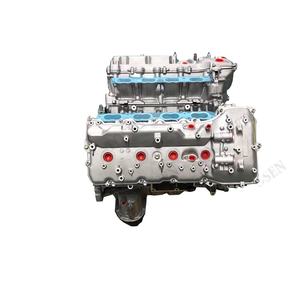Discovering the most effective Deals on Opel Corsa Engine Components
Wiki Article
Exploring the Inner Operation of a Compact Automobile's Engine System
As chauffeurs, we frequently consider granted the elaborate processes that take place within the boundaries of our car's engine system. The portable yet intricate equipment that propels us ahead is a marvel of design accuracy and sychronisation. From the regulated explosions in the combustion chamber to the meticulous timing of gas shot, every element plays an essential role in the smooth operation of the engine. In this expedition of a small car's engine system, we will certainly unravel the internal functions of this mechanical symphony, clarifying the secrets that drive us onward on our daily trips.Combustion Process Overview
The combustion process in a compact lorry's engine system is an essential device that successfully converts fuel into energy to power the vehicle. This process happens within the burning chamber of the engine, where gas and air mix, stir up, and create regulated explosions. The combustion procedure includes four primary stages: consumption, exhaust, compression, and power.Throughout the intake stage, the piston relocates downward, attracting a blend of air and fuel right into the burning chamber. The next stage, compression, includes the piston moving up, compressing the air-fuel mixture to increase its potency. Consequently, in the power stage, the ignition system stirs up the pressed combination, resulting in a fast expansion of gases that forces the piston pull back. This descending movement produces the power required to drive the lorry. In the exhaust stage, the burnt gases are eliminated from the combustion chamber with the exhaust shutoff, preparing the chamber for the following cycle. This cyclic burning process is essential to the operation of a compact lorry's engine system, ensuring reliable power conversion for propulsion.
Piston and Cyndrical Tube Interaction

The piston's exact fit within the cylinder is essential for keeping ideal compression and protecting against energy loss during combustion. Limited clearances in between the piston and cyndrical tube walls make certain effective sealing, enabling the piston to move smoothly without enabling gases to leakage past. Correct lubrication is additionally essential to reduce rubbing and wear between these elements, enhancing durability and performance.
Additionally, the style and products utilized in making the piston and cylinder impact engine efficiency and resilience. Modern engines usually use light-weight yet durable materials like aluminum alloys for pistons and cylinder liners to minimize inertia and boost thermal effectiveness. On the whole, the unified interaction between the piston and cyndrical tube is essential to the engine's performance and total efficiency.
Fuel Injection System Capability
Fuel shot systems in portable car engines play a vital function in precisely providing gas to the burning chamber for controlled and effective ignition. The gas injection system operates by infusing fuel into the burning chamber at the ideal minute throughout the engine's procedure (opel corsa engine). This exact timing makes sure that the gas blends equally with the air for proper combustion, leading to improved gas effectiveness and lowered dischargesThere are primarily 2 types of gas shot systems used in compact lorry engines: port fuel injection useful site (PFI) and direct fuel shot (DFI) PFI systems inject fuel right into the intake port before the intake shutoff, while DFI systems infuse fuel straight right into the combustion chamber. Both systems have their benefits, with DFI offering much better gas atomization check out this site and PFI providing an extra cost-efficient option.
Understanding Engine Cooling Devices
Reliable operation of a portable lorry's engine depends heavily on the performance of its cooling devices. The air conditioning system in a compact vehicle commonly is composed of several parts functioning with each other to control the engine temperature. Recognizing these engine air conditioning systems is essential for preserving the performance and longevity of a portable lorry's engine system.
Exhaust System Elements Explained
The ideal performance of a small automobile's engine air conditioning devices depends on a complementary system referred to as the exhaust system, which comprises different necessary parts for ensuring reliable exhausts and engine performance. The exhaust system consists of parts such as the exhaust manifold, catalytic converter, muffler, and tailpipe. The exhaust manifold gathers exhaust gases from the engine's routes and cylinders them to the catalytic converter. The catalytic converter then converts dangerous contaminants in the exhaust right into less harmful exhausts before releasing them through the muffler and tailpipe.One crucial element of the exhaust system is the oxygen sensing unit, which checks the oxygen levels in the exhaust gases to assist manage gas usage and make sure optimum engine performance. opel corsa engine. Furthermore, the resonator might exist in some exhaust systems to minimize noise degrees. Overall, the exhaust system plays an important duty in maintaining engine effectiveness, lowering hazardous emissions, and making sure a quieter driving experience for portable car proprietors

Verdict
To conclude, the portable lorry's engine system is a complicated mix of parts that work with each other to explanation facilitate the combustion procedure, convert fuel into energy, and expel waste gases. Understanding the internal operations of the engine system, consisting of the piston and cylinder communication, fuel shot system, engine air conditioning mechanisms, and exhaust system elements, is critical for maintaining ideal performance and efficiency of the lorry.The combustion procedure in a portable automobile's engine system is an essential device that successfully converts gas into power to power the lorry.Gas injection systems in compact lorry engines play a critical role in exactly delivering gas to the burning chamber for reliable and regulated ignition.There are largely 2 kinds of gas injection systems utilized in portable lorry engines: port fuel shot (PFI) and straight gas shot (DFI) Understanding these engine cooling devices is important for preserving the efficiency and longevity of a small car's engine system.
The optimum functioning of a portable car's engine cooling devices depends on a complementary system recognized as the exhaust system, which makes up numerous necessary components for guaranteeing efficient emissions and engine performance.
Report this wiki page